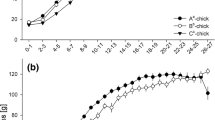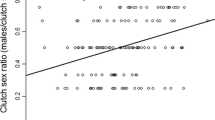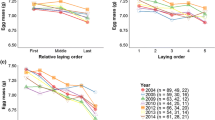Abstract
Reproductive effort, egg number and egg size are traditionally considered to be ‘female’ life history traits. However, females often adjust the amount of resources allocated to reproduction depending on their mate, causing male environmental effects on life history traits. If females respond to male traits which are genetically variable, then male environmental effects contain indirect genetic effects. Estimates of how much of the total variation in life history traits originates from female effects versus male environmental effects, seems mostly lacking. We have investigated variation in rates of egg production and in egg size in the annual Argentinian blackfin pearl killifish Austrolebias nigripinnis, in a crossed design where males were exchanged repeatedly between females. Our analysis of phenotypic variance components of reproductive effort, egg size and egg number indicates that the amount of variation contributed by male environmental effects is equal (egg size, reproductive effort) or larger (egg number) than that between females. For egg size and number, we find that male environmental effects consist of a male random effect representing the average response of females to male phenotype, plus a female-male interaction term. This term can be understood as the deviation from the population mean of an individual female’s response. For reproductive effort, we find that the male environmental effect consists of an interaction term only. Random effects on egg size and number additionally vary in magnitude depending on the weekday where we collected eggs, probably due to cyclic variation in experimental conditions. Since we find that both male phenotype and environmental conditions affect egg size and number as determined by females, our results suggest that selection on these life history traits will be frequency-dependent.

Similar content being viewed by others
References
Agrawal AF, Brodie ED III, Wade MJ (2001) On indirect genetic effects in structured populations. Am Nat 158:308–323
Alderdice DF (1988) Osmotic and ionic regulation in teleost eggs and larvae. In: Hoar WS, Randall DJ (eds) Fish physiology, vol XIA. Academic Press Inc, London, pp 163–251
Arezo MJ, D’Allesandro S, Papa N, de Sá R, Berois N (2007) Sex differentiation pattern in the annual fish Austrolebias charrua (Cyprinodontiformes: Rivulidae). Tissue Cell 39:89–98
Arnqvist G, Rowe L (2005) Sexual conflict. Princeton University Press, Princeton
Bates D (2005) Fitting linear mixed models in R. R News 5:27–30. Available from http://CRAN.R-project.org/doc/Rnews/
Bolker BM, Brooks ME, Clark CJ, Geange SW, Poulsen JR, Stevens MH, White JS (2009) Generalized linear mixed models: a practical guide for ecology and evolution. TREE 24:127–135
Brown MB, Forsythe AB (1974) Robust tests for equality of variances. J Am Stat Ass 69:364–367
Carroll RJ, Ruppert D, Stefanski LA, Crainiceanu C (2006) Measurement error in nonlinear models, a modern perspective, second edition. Chapman & Hall/CRC Press, Boca Raton
Chambers RC, Waiwood KG (1996) Maternal and seasonal differences in egg sizes and spawning characteristics of captive Atlantic cod, Gadus morhua. Can J Fish Aquat Sci 53:1986–2003
Chenoweth SF, Rundle HD, Blows MW (2010) Experimental evidence for the evolution of indirect genetic effects: changes in the interaction effect coefficient, PSI (Ψ), due to sexual selection. Evolution 64:1849–1856
Chow CY, Wolfner MF, Clark AG (2010) The genetic basis for male × female interactions underlying variation in reproductive phenotypes of Drosophila. Genetics 186:1355–1365
Clark AG, Begun DJ, Prout T (1999) Female × male interactions in Drosophila sperm competition. Science 283:217–220
Crawley MJ (2005) Statistics: an introduction using R. Wiley, New York
Cunningham EJA, Russell AF (2000) Egg investment is influenced by male attractiveness in the mallard. Nature 404:74–77
Czesak ME, Fox CW (2003) Evolutionary ecology of size and number in a seed beetle: genetic trade-offs differ between environments. Evolution 57:1121–1132
Einum S, Fleming IA (1999) Maternal effects of egg size in brown trout (Salmo trutta): norms of reaction to environmental quality. Proc R Soc Lond B 266:2095–2100
Einum S, Hendry AP, Fleming IA (2002) Egg-size evolution in aquatic environments: does oxygen availability constrain size? Proc R Soc Lond B 269:2325–2330
Errea A, Danulat E (2001) Growth of the annual fish, Cynolebias viarius (Cyprinodontiformes), in the natural habitat compared to laboratory conditions. Environ Biol Fishes 61:261–268
Evans JP, Box TM, Brooshooft P, Tatler JR, Fitzpatrick JL (2010) Females increase egg deposition in favor of large males in the rainbowfish, Melanotaenia australis. Behav Ecol 21:465–469
Fleming IA, Ng S (1987) Evaluation of techniques for fixing, preserving and measuring salmon eggs. Can J Fish Aquat Sci 44:1957–1962
Gall GAE, Neira R (2004) Genetic analysis of female reproduction traits of farmed coho salmon (Oncorhynchus kisutch). Aquaculture 234:143–154
Griffing B (1981) A theory of natural selection incorporating interaction among individuals. I. The modeling process. J Theor Biol 89:635–658
Hendry AP, Day T (2003) Revisiting the positive correlation between female size and egg size. Evol Ecol Res 5:421–429
Hendry AP, Day T, Cooper AB (2001) Optimal size and number of propagules: allowance for discrete stages and effects of maternal size on reproductive output and offspring fitness. Am Nat 106:387–407
Hui W, Gel YR, Gastwirth JL (2008) Lawstat: an R package for law, public policy and biostatistics. J Stat Soft 28:1–26
Hunt J, Brooks R, Jennions MD (2005) Female mate choice as a condition-dependent life-history trait. Am Nat 166:79–92
Ihaka R, Gentleman R (1996) R: a language for data analysis and graphics. J Comp Graph Stats 5:299–314
Ingleby FC, Hunt J, Hosken DJ (2010) The role of genotype-by-environment interactions in sexual selection. J Evol Biol 23:2031–2045
Jonsson N, Jonsson B, Fleming IA (1996) Does early growth cause a phenotypically plastic response in egg production of Atlantic salmon? Funct Ecol 10:89–96
Kamler E (2005) Parent-egg-progeny relationships in teleost fishes: an energetics perspective. Rev Fish Biol Fisheries 15:399–421
Kolm N (2001) Females produce larger eggs for large males in a paternal mouthbrooding fish. Proc R Soc Lond B 268:2229–2234
Kolm N, Stein RW, Mooers AØ, Verspoor JJ, Cunningham EJ (2007) Can sexual selection drive female life histories? A comparative study on Galliform birds. J Evol Biol 20:627–638
Koops MA, Hutchings JA, Adams BK (2003) Environmental predictability and the cost of imperfect information: influences on offspring size variability. Evol Ecol Res 5:29–42
Lande R (1976) Natural selection and random genetic drift in phenotypic evolution. Evolution 30:314–334
McFarlane ML, Cherry MI, Evans MR (2010) Female Cape sugarbirds (Promerops cafer) modify egg investment both for extra-pair mates and for male trail length. J Evol Biol 23:1998–2003
McGlothlin JW, Brodie ED III (2009) How to measure indirect genetic effects: the congruence of trait-based and variance-partitioning approaches. Evolution 63:1785–1795
Meffert LM (1995) Bottleneck effects on genetic variance for courtship repertoire. Genetics 139:365–374
Meffert LM (2000) The evolutionary potential of morphology and mating behavior: the role of epistasis in bottlenecked populations. In: Wolf JB, Brodie ED III, Wade MJ (eds) Epistasis and the evolutionary process. Oxford University Press, Oxford, pp 177–193
Moore AJ, Brodie ED III, Wolf JB (1997) Interacting phenotypes and the evolutionary process: I. Direct and indirect genetic effects of social interactions. Evolution 51:1352–1362
Olofsson H, Ripa J, Jonzén N (2009) Bet-hedging as an evolutionary game: the trade-off between egg size and number. Proc R Soc Lond B 276:2963–2969
Pakkasmaa S, Peuhkuri N, Laurila A, Hirvonen H, Ranta E (2001) Female and male contribution to egg size in salmonids. Evol Ecol 15:143–153
Petfield D, Chenoweth SF, Rundle HD, Blows MW (2005) Genetic variance in female condition predicts indirect genetic variance in male sexual display traits. Proc Natl Acad Sci USA 102:6045–6050
Philippi T, Seger J (1989) Hedging ones evolutionary bets, revisited. TREE 4:41–44
Pinheiro JC, Bates DM (2000) Mixed-effects models in S and S-PLUS. Springer, New York
Podrabsky JE, Hrbek T, Hand SC (1998) Physical and chemical characteristics of ephemeral pond habitats in the Maracaibo basin and Llanos region of Venezuela. Hydrobiologia 362:67–78
Polačik M, Reichard M (2009) Indirect fitness benefits are not related to male dominance in a killifish. Beh Ecol Sociobiol 63:1427–1435
Rideout RM, Morgan MJ (2010) Relationships between maternal body size, condition and potential fecundity of four north-west Atlantic demersal fishes. J Fish Biol 76:1379–1395
Roff DA (1992) The evolution of life histories: theory and analysis. Chapman and Hall, New York
Rueffler C, Van Dooren TJM, Metz JAJ (2006) The evolution of resource specialization through frequency-dependent and frequency-independent mechanisms. American Naturalist 167:81–93
Sheldon BC (2000) Differential allocation: tests, mechanisms and implications. TREE 15:397–402
Skinner AJ, Watt PJ (2007) Strategic egg allocation in the zebra fish, Danio rerio. Behav Ecol 18:905–909
Smoker WW, Gharrett AJ, Stekoll MS, Taylor SG (2000) Genetic variation of fecundity and egg size in anadromous pink salmon Oncorhynchus gorbuscha Walbaum. Alaska Fishery Research Bulletin 7:44–50
Spence R, Smith C (2006) Mating preference of female zebrafish, Danio rerio, in relation to male dominance. Behav Ecol 17:779–783
Stearns SC (1992) The evolution of life histories. Oxford University Press, Oxford
Stram DO, Lee JW (1994) Variance components testing in the longitudinal fixed effects model. Biometrics 50:1171–1177
Taborsky B (2006a) The influence of past and present environments on adult life history decisions. Proc Roy Soc Lond B 274:741–750
Taborsky B (2006b) Mothers determine offspring size in response to own filial growth conditions. Biol Lett 2:225–228
van Noordwijk A, de Jong G (1986) Acquisition and allocation of resources: their influence on variation in life history tactics. Am Nat 128:137–142
Verbeke G, Molenberghs G (2000) Linear mixed models for longitudinal data. Springer, New York
Wade MJ (2000) Epistasis: genetic constraint within populations and accelerant of divergence among them. In: Wolf JB, Brodie ED III, Wade MJ (eds) Epistasis and the evolutionary process. Oxford University Press, Oxford, pp 213–231
Wolf JB (2000) Indirect genetic effects and gene interactions. In: Wolf JB, Brodie ED III, Wade MJ (eds) Epistasis and the evolutionary process. Oxford University Press, Oxford, pp 158–176
Wolf JB, Brodie ED III, Cheverud JM, Moore AJ, Wade MJ (1998) Evolutionary consequences of indirect genetic effects. TREE 13:64–69
Wourms JP (1972) The developmental biology of annual fishes. III. Pre-embryonic and embryonic diapause of variable duration in the egg of annual fishes. J Exp Zool 182:389–414
Acknowledgments
We thank Martin Fourcade and GAK for hospitality and assistance during fieldwork in Argentina. The Ministry of Science, Research and Technology of Iran provided funding for MM. Martine Maan gave comments on a previous version of this manuscript. All animals were kept, bred and handled in accordance with Dutch animal welfare regulations.
Author information
Authors and Affiliations
Corresponding author
Rights and permissions
About this article
Cite this article
Moshgani, M., Van Dooren, T.J.M. Maternal and paternal contributions to egg size and egg number variation in the blackfin pearl killifish Austrolebias nigripinnis . Evol Ecol 25, 1179–1195 (2011). https://doi.org/10.1007/s10682-011-9469-7
Received:
Accepted:
Published:
Issue Date:
DOI: https://doi.org/10.1007/s10682-011-9469-7




